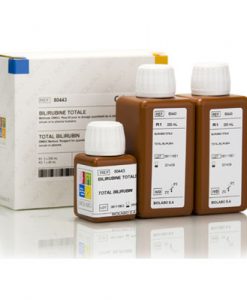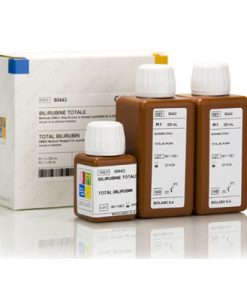Cromatest Albumin Biochemistry Reagent – 100 Test
৳ 1,140৳ 1,300 (-12%)
In stock
Cromatest Albumin Biochemistry Reagent
Packaging Size: 1x100 ml
Origin: Spain
Brand : Cromatest / Linear
Packaging Type: Bottle
Test/Pack: 100 Test
Method: colorimetric method
Cromatest Albumin Biochemistry Reagent
PRINCIPLE
The method1 is based on the specific binding of bromocresol green (BCG), an anionic dye, and the protein at acid pH with the resulting shift in the absorption wavelength of the complex. The intensity of the color formed is proportional to the concentration of albumin in the sample.
REFERENCE VALUES3
Serum, plasma
Adults: 3.81-4.65 g/dL (38.1-46.5 g/L)
The range of values for hospitalized individuals varies between 1.4 and 4.8 g/dL.
It is recommended that each laboratory establishes its own reference range.
Best Quality Diagnostic Products Buy from Medistore

REAGENT COMPOSITION:
R1: Bromocresol reagent. Succinate buffer 75 mmol/L pH 4.2, BCG 0.12 mmol/L, tensioactive 2 g/L (w/v
R2:Albumin standard. Bovine serum albumin 5 g/dL (50 g/L) Secondary standard traceable to SRM 927b
STORAGE AND STABILITY:
Store at 2-8ºC.
The Reagents are stable until the expiry date stated on the label
SAMPLES
Serum or EDTA plasma.
Albumin in serum and plasma is stable for 2 weeks at 2-8ºC, and for up to 4 months at –20ºC.
Buy Hematology Analyzer Reagent at best price from Medistore
QUALITY CONTROL
The use of a standard to calculate results allows to obtain an accuracy independent of the system or instrument used.
To ensure adequate quality control (QC), each run should include a set of controls (normal and abnormal) with assayed values handled as unknowns.
CLINICAL SIGNIFICANCE
The serum content of the soluble proteins, those circulating in extracellular and intracellular fluids, has been used as a marker to aid in clinical diagnosis. The main diagnostic tests are those measuring serum total protein and serum albumin.
Collectively, serum total protein including albumin is mainly involved in the maintenance of normal water distribution between tissues and the blood and responsible for maintaining the oncotic pressure of plasma and is used to transport many substances including macromolecules.
Hiperproteinemia o hiperalbuminemia, usually occurs during multiple mieloma caused by high levels of the monoclonal immunoglobulins, dehydration, excessive water loss, as in severe vomiting, diarrhea, Addisons´s disease or diabetic acidosis. The hemoconcentration, decrease in the volume of plasma water, is reflected as a relative hyperproteinemia since concentration of all the individual plasma proteins are increased to the same degree.
Hypoproteinemia o hypoalbuminemia usually occurs in edema, malnutrition, nephrotic syndrome, malabsortion and severe liver cirrhosis. Since albumin is present in such high concentration low levels of this protein alone may also cause hypoproteinemia.
ANALYTICAL PERFORMANCE
- Linearity:Up to 7.0 g/dL
- Precision
| g/dL | Within-run | Between-run | ||||
| Mean | 3.7 | 5.1 | 6.9 | 3.7 | 5.1 | 7.0 |
| SD | 0.02 | 0.02 | 0.05 | 0.03 | 0.05 | 0.07 |
| CV% | 0.80 | 0.39 | 0.70 | 0.80 | 0.98 | 0.75 |
| N | 10 | 10 | 10 | 10 | 10 | 10 |
Replicates: 10 for each level. Replicates: 10 for each level Instrument: CECIL CE 2021 for 8 days.
- Sensitivity. Using a 1:200 sample/reagent at 630 nm, 1 g of albumin will produce a net absorbance of approximately 1865.
- Correlation. This assay (y) was compared with a similar commercial method (x). The results were:
N = 40 r = 0.994 y = 1.035 + 1.040
INTERFERENCES
-
-
- Heparin interferes with this dye binding 2
- Specimens containing dextran should be
- Lipemic samples (triglycerides > 10 g/L), require a blank Use the same volume of sample with isotonic saline in the place of the reagent.
- Hyperbilirubinemia or hemolysis does not affect the assay since the absorption maximum of the complex absorbs at a
wavelength distinct from those at which bilirubin and hemoglobin interfere.3
-
MATERIALS REQUIRED
- Photometer or colorimeter capable of measuring absorbance at 630 ± 20 nm.
- Pipettes to measure reagent and
- This is not necessary if the assay is performed in an automated instrument.
PROCEDURE
- Bring reagents and samples to room temperature
- Pipette into labelled tubes:
TUBES
Blank
Sample
Standard
Reagent 2.0 mL 2.0 mL 2.0 mL Sample – 10 mL – Standard – – 10 mL The color is stable for 30 minutes protected from light.
3.Mix and let stand the tubes 10 minutes at room temperature.
- 4.Read the absorbance (A) of the samples and the standard at 630 nm against the reagent
CALCULATIONS
Samples with concentrations higher than 8 g/L should be diluted 1:2 with saline and assayed again. Multiply the results by 2.
If results are to be expressed as SI units apply: g/dL x 10 = g/L
REFERENCES
- Doumas, T., Watson, W.A. and Biggs, H.G. Clin. Chim. Acta. 31 : 87 (1971).
- Bonvicini, , Ceriotti, G., Plebani, M. and Volpe, G. Clin. Chem. 25 : 1459 (1979).
- N.W. Fundamentals of Clinical Chemistry, p. 940. W.B. Saunders Co. Philadelphia, PA. (1987).
- Wolf, L. Methods and Techniques in Clinical Chemistry, Willey, Interscience, N.Y. (1972).
Brand
Chromatest
Linear
You must be logged in to post a review.








Reviews
There are no reviews yet.